ASUS Maximus III Extreme - P55 for $349
by Rajinder Gill on April 26, 2010 1:32 AM EST- Posted in
- Motherboards
Nothing special to report against other P55 boards, we all know the drill by now:
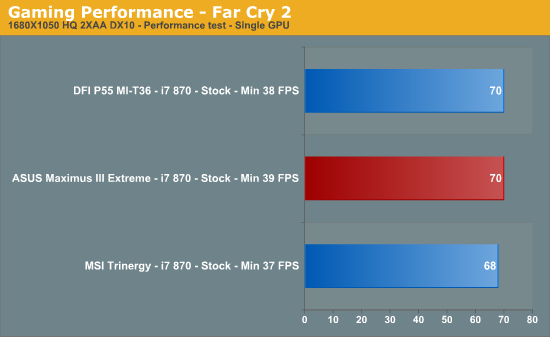

Power Consumption
Our power consumption testing utilizes the same batch of components under similar circumstances in a bid to monitor variances between idle and CPU load conditions. We install the vendor supplied power saving utilities on each board and enable power saving modes that don't involve any kind of underclocking or CPU core frequency modulation in order to run an apples to apples comparison.
ATX PSU switching losses are absent from our figures because we monitor power consumption directly at the DC rails of the PSU. These figures measure only the CPU, motherboard and memory DC power draw and exclude any other peripherals such as 12V ATX power draw for the graphics card, or any power for case cooling fans and hard drives etc. Actual AC power consumption for the motherboard will be anywhere from 15~40% higher than these figures depending upon the efficiency of your power supply.
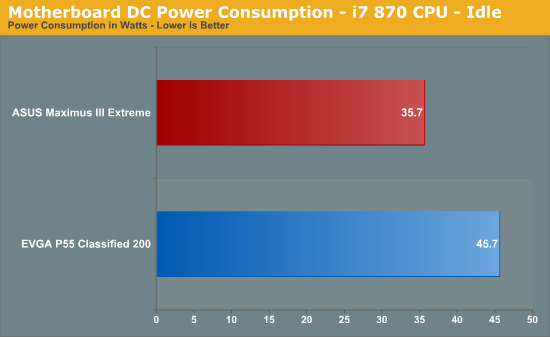
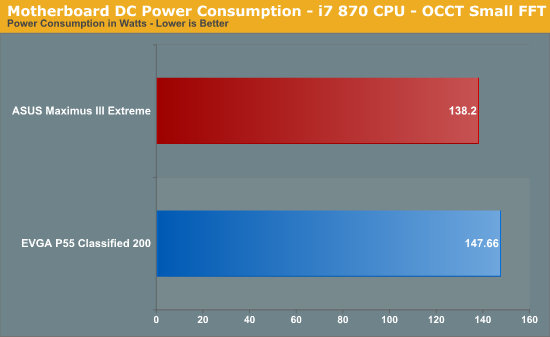
The ASUS M3E comes out on top in both idle and full load conditions due to a more efficient VRM for VCC. Minimum switching frequency on the ASUS board is 250KHz, compared to the Classified's 800KHz 10 phase Volterra solution.
Overclocking
Using air and water cooling, most P55 boards are on an even keel, it’s all about the CPU. Our retail i5-750 and i7 - 860 both reached the same frequencies on this board as they have on everything we’ve tried them on before:
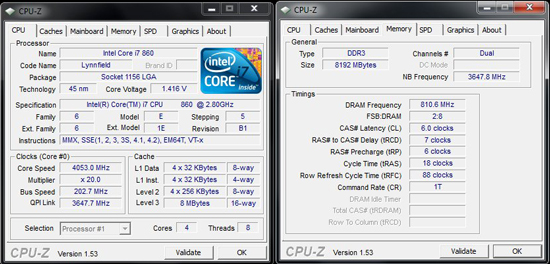
The retail CPU’s aren’t that good, so we checked out what was possible with a good ES just to make sure everything is a-ok.

4.4GHz will pass Linpack under watercooling with this chip, and on the M3E we got that pretty easily, we’re limited by temps here because we’re hitting temps in the mid 80 Celsius region under full load.
We also made some compares using sub-zero cooling using a dual rotary cascade. The testing itself was just basic enough to find maximum frequencies in both heavy-load and light-load synthetic benchmarks. Like other boards out there, cold booting Clarkdale processors requires the modification of the onboard PEGR BIAS compensation resistor either by shorting it or replacing it with a potentiometer and dialling down to a usable value. This late in the game, we were expecting ASUS to have addressed this with a litte finesse or some kind of control via a GPIO. Be prepared to sue a little conductive ink if you want to benchmark this board below -100 Celsius.
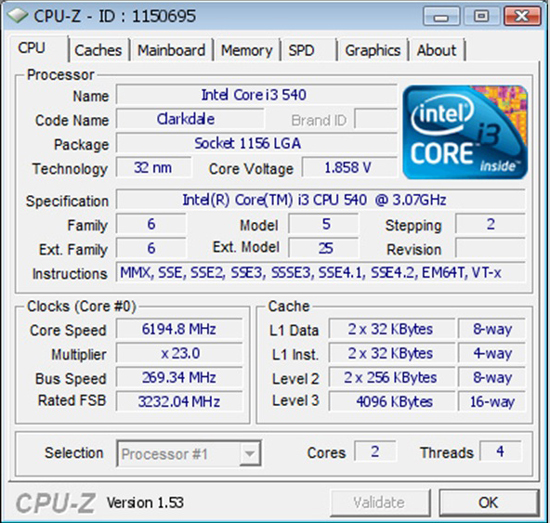

During heavy load benchmarks like Vantage, the EVGA scores slightly better in single card:
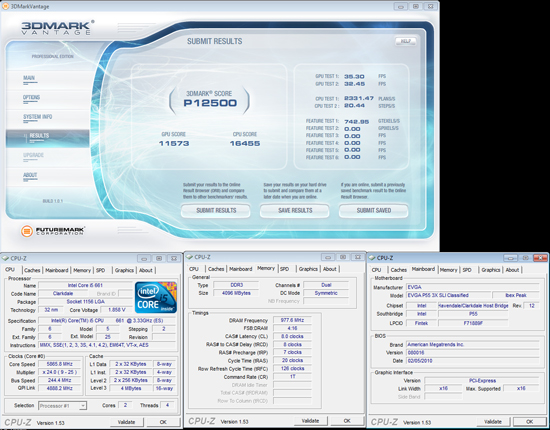
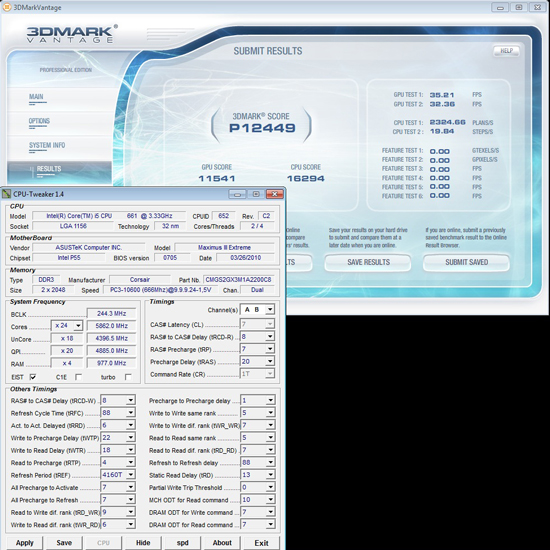
Super Pi 32M next:

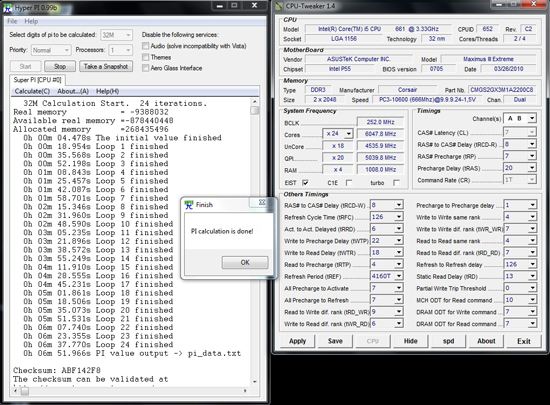
Where ASUS have got things right though is that it’s far easier maxing out a CPU on the M3E than it is on EVGA’s E659 Classified 200. The Classified 200 has a lot more hardware tweaks, but in this instance we found that we had to use those tweaks to keep up with the M£E rather thans surpass it. In fact, you have to take a lot more time making adjustments on the EVGA board to get the same clock speeds as the ASUS M3E in almost every bench. That's why the 32M scores are a little behind on the EVGA E659 - we tired out the OS trying to match the M3E's clock speed in Super Pi. Put simply, the M3E is easier to overclock in most areas.
There’s probably a little room for fine tuning of how the ASUS board posts over 220 BCLK when using higher QPI ratios; certain CPU multiplier ratio’s can’t be engaged from a power cycle, so its a case of setting a low CPU multiplier at first post, re-enering BIOS and then changing the ratio to suit your desired operating frequency. Still, it’s something that only manifests when pushing real hard, we’ve yet to come across a board that does not have some kind of quirk when it comes to increased QPI speeds and booting past 220 BCLK.










22 Comments
View All Comments
gasgas - Monday, April 26, 2010 - link
Outstanding review anand, some very nice features on the ASUS board, one has to ask though, if P55 is costing this much is it really worth the effort, why not just get a budget X58 and have more on tap.Makaveli - Monday, April 26, 2010 - link
Why are the screenshots so big?I felt I should have been wearing glasses or something... and I don't wear glasses!
classy - Monday, April 26, 2010 - link
$350 is too much for P55. You can get a serious X58 board for that kind of moneyloghead - Monday, April 26, 2010 - link
good luck to everyonedingetje - Tuesday, April 27, 2010 - link
wouldn't pay more than 100 bucks for it though :)v12v12 - Tuesday, April 27, 2010 - link
I dunno maybe it's me, but we're talking near $400 for a system board? Three-hundred and fifty dollars (& ~$26 tax), that's just lunacy to even bother with. Has anyone ever done some basic, logical mathematics on cost/performance? These so-called "performance/'OC'er" mobos offer barely any noticeable advantages over a solid mid-level board vs the exuberant price people will rationalize. Paying nearly 100% more for hardly 15% performance advantage? For the same money you could buy enhanced cooling equipment for your mid-level board and soar past that waste of a PCB, dollar for dollar.The fanaticism over these "top-end," yet financially inefficient mobos, is just laughable; even the suggestion of purchasing one is also. People are rationalizing spending MORE, for lesser performance per dollar; THIS is ILLOGICAL, and stupid? I say Anand spend more time on solid mid to lower-upper builds vs playing fantasy article on a "gold-sample" OC'er board that offers little in reality for; I dunno maybe ~90% of the readership, whom will not be purchasing boards anywhere near that price range? Articles like these waste the writers' time and the readers'. Also it's money down the drain from a budget, which could be spent on better informing majority of the readers on systems they can actually afford or save for. $349, come on lol. That's a very nice trip somewhere on a plane, buddy... Vs an "OC'ers system-board." These prices are ridiculous and you all keep feeding the (advertising) market for them.
__Yep it's ALL marketing folks... they (Manu's/tech sites etc.) know most of you will never get one of these boards, it's just a dream; they are loss-leaders. They know it's great advertising for the manufacturer, who doesn't expect to make a profit from said board. It's to demonstrate to the "market" (their competitors) their current/alleged technological capabilities. All the while we're getting articles, which use up resources from more in depth guides, builds, discussions about what most people have, can afford, or will save for... Fantasy-land articles are great for the uber enthusiast, but it's boring knowing I'm never going to waste anywhere near that much for this stuff... I'll just see it a couple gens later; wow I feel like a psychic, I just knew exactly what board I'll get when the price is right... Bunk.
More meat, less fat please... Thx staff.
Rajinder Gill - Tuesday, April 27, 2010 - link
Hi,This is the first $200+ motherboard review we've posted in 2010. The last 13 boards reviewed were sub $200 (a lot under $150). So I don't think its a case of us getting carried away and not providing any "meat" for the readership.
There will be some high-end boards reviewed over the coming months, but also a number of budget priced ones as time progresses.
regards
Raja
Nickel020 - Tuesday, April 27, 2010 - link
The gaming performance differences between the M3E and the Trinergy are way larger than I've come to expect of same chipset boards: Sometimes the M3E is ~10% faster than the Trinergy, sometimes it's the other way around. If I didn't know that you know what you're doing I'd think this was sloppy benchmarking... How do you explain the large differences? At second glance it looks like the Trinergy does better in multi-GPU setups, while the M3E leads in single GPU setups.Also, I did not expect such a large difference between the 920 @4GHz and the P55 boards with the CPU @4GHz when using triple SLI, is this to be attributed to the NF200, to the on-die PCI-E controller (not enough lanes?) or even the lack of a third memory channel? Is the difference also this big on dual SLI between X58 and P55+NF200 boards? And how do non-NF200 boards fare?
Rajinder Gill - Tuesday, April 27, 2010 - link
Hi,The disparity you see in the M3E and Trinergy multi-card results is not down to 'sloppy benchmarking'. We saw this back when we reviewed the Trinergy board too against the P55 Classified 200. My personal take on the difference is that it’s possibly down to how the NF200 is strung onto the primary PEG lanes.
MSI supplies all 16 lanes direct to the NF200 - this gives them slightly worse single card performance. However, as nVidia have a couple of front end features within the NF200 that can be utilized for SLI, when more than one card is plugged in boards like the M3E and Classified 200 which keep eight of the primary PEG lanes native to the CPU incur a performance hit, possibly due to an additional command hop front to back on the NF200. That's about the only thing I can think that causes this. ASUS have actually added a lot of lane switches to the M3E to provide 4 card support, those little lane switches and trace routing all add extra latency too.
We don't go to press with figures that are out of whack, anything we find with a disparity is double and triple checked before we post it up.
Regards
Raja
Rajinder Gill - Tuesday, April 27, 2010 - link
Forgot to add, for additional results showing other P55 boards with the trinergy - check some of the results here:
http://www.anandtech.com/show/2894/6